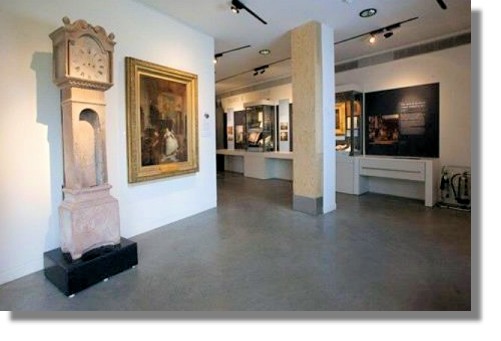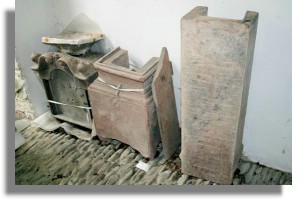
Sir Walter Scott's Sandstonee Clock at Abbotsford
Did You Know?
- Sir Walter Scott's Sandstone Clock

Sir Walter Scott's Sandstonee Clock at Abbotsford

Background
The Abbotsford Trust safeguards Abbotsford, the Home of Sir Walter Scott, one of the most iconic literary houses in the world. They are looking for support to restore and conserve Abbotsford, and develop new learning and engagement programmes that will bring the world of Walter Scott to new audiences.The restoration and history of Sir Walter Scott's sandstone longcase clock is one of their many projects. The clock was found in storage and is likely to be the only one of its kind in the world.
The Clock
The recent find at Abbotsford has not bowed to time's power and was expertly hewn from massive blocks of sandstone, Sir Walter Scott's Regency (Georgian) longcase grandfather clock was made entirely to his specifications, is a testament to the wits of the author and the craftsmanship of its makers. Likely to have been created by the Smiths of Darnick, experts have never seen anything like it in any other collection in the world.In pieces for over 100 years, it was rediscovered in November 2016. It is now on display to the public, having been proudly added to the Abbotsford exhibition. It is hoped to breathe new life into the clock by restoring its movement and replacing the original sandstone door with a window through which visitors can see the moving pendulum.
Clock Details
This piece is perhaps one of the most unusual in the Abbotsford collections and symbolises the unique character and wit of Sir Walter Scott´s interiors. Stylistically, the carved architectural ornaments on the top imitate those found on Georgian longcase clocks made from woods such as mahogany and oak. However this example is unique in being entirely hewn from local sandstone. The finished product is testament to the considerable skill of the mason responsible for sculpting the three individual sections that lock together. Mortise and tenon joints ordinarily found in carpentry have been expertly recreated in stone, complete with a hinged sandstone door allowing access to the pendulum within.
The door has survived but a substantial fragment has been lost earlier its life, along with the original hinges. After careful consideration it has been decided not to attach new steel hinges to the stonework, preferring to preserve what remains of the weighty door at Abbotsford due to its fragility. They are currently exploring other ways of shielding the movement once it is installed and this work will constitute phase 2 of the restoration. The hollow interior of the trunk, the bored holes in the face for the hands and winding keys, and the provision for access points to the inside of the hood all indicate that this was a working clock, although tragically its original movement has not survived. John Smith of Darnick´s diary, which details his work as a mason at Abbotsford, mentions sending a plan of a clock to an Edinburgh clockmaker in August 1823 in the company of his brother Tom. It is assumed that these must have been the plans for this piece.
Original Location of the Clock
The conservatory, on the left in the photo here, is likely to have been the home of the clock The clock´s history remains very mysterious, but recent conservation work has enabled some conclusions to be drawn about its past. The absence of any significant erosion or biological damage indicates that the clock was housed inside, rather than in the gardens as you might expect. The rough-hewn nature of the back suggests that it once stood against a wall, or possibly in a niche. No niche of the correct dimensions exists in the Orangery in the Kitchen Garden, and so much has been written about Abbotsford´s interiors and contents over the last two hundred years that it is highly unlikely that the clock stood in Scott´s public apartments. The most likely explanation is that this quirky piece was housed in the original Conservatory of Abbotsford, demolished in the 1850s during the creation of the West or Hope-Scott Wing. This room was on the ground-floor but tended to be considered a private family space. Abbotsford are delighted to showcase this piece but this is only the first step of its restoration. They are now working with a local clockmaker to get Scott´s unique sandstone clock ticking once again! If you would like to support this restoration work including fitting a new movement to the clock, you can visit their Just Giving Campaign to donate.
Acknowledgement
This article is based on text and graphics provided by Abbotsford Trust.
Where else would you like to go in Scotland?

